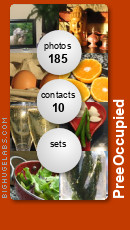It wasn't supposed to be like this. I was supposed to be a cookbook-writing Bengali. I was supposed to have my own cooking show. I was meant to sign my cook books. I was supposed to look all fab, and flaunt my manicured nails while chopping onions on television. I was meant to look like a Bengali version of Goddess Nigella, in lal-parer sari and sindur’er teep.
But here I am. working 8:30 to 5 pm.Taking the subway home each day from the financial district of TO. If I am lucky, I can get into the first train that arrives on the platform while I am waiting. Waiting with the hundreds of people on the downtown subway station. Everyone looks the same. In a hurry. Dressed in black. Tired. Withdrawn. Like workdogs, who are only trained to well…work! I have become one of them. I am one of them.
I dress in black, not because it looks classy, but because its easy to dress in. And it also makes me look slim.
Its another thing that three-fourths of my wardrobe is black.
And then I see color peeking through the dark clouds and the dark clothes all around me. Vibrant, luscious, beautiful colors in the ingredients of Shukto. Green, white, purple, yellow, and some more green.
Shukto or Shuktoni is a medley of fresh vegetables. It has the perfect balance of bitter, sweet and savory. A food very sophisticated and time taking to cook. Its always made from scratch in Bengali homes. Its a starter for many memorable meals. This dish is made to be mopped clean with rice. Eat the shukto and rice with your hands and experience manna-like experience down here on Earth. Incredibly enough, the Shukto is personally satisfying and it has been on my agenda to share it with you.
Its a pretty engaging recipe with several vegetables and ingredients. But the key ingredient for traditional Shukto is bittergourd or karela and a whole spice blend we call paanch phoron - fenugreek seed, Nigella seed, cumin seed, celery seed and fennel seed in equal quantities. Apart from the usual ginger paste, posto paste and yellow mustard paste.
For this dish, Bengalis typically use easily available vegetables in the Summer season. I have used uchche (bittergourd), sheem (broadbeans), shojne data (drumsticks), begun (Oriental eggplant), alu (potato), potol (parwal, sorry I do not know the English name!), lal alu (sweet potato), and mulo (radish).
On another day, if I do not find any of the green vegetables in the Bangladeshi store, I’d replace it with borboti (longyard beans), or kanch kola (green banana). But uchche is a must! Anyone cooking THE Shukto without bittergourd is not really a Shukto.
Ingredients for Shukto
1 large bittergourd, cut lengthwise into two inch pieces
1 large white potato, cut into two inch large sticks or Batonnet
1 medium size sweet potato, cut into Batonnets
Handful of fresh drumsticks, cut into two inch pieces
1 plump Oriental eggplant, cut lengthwise into two inch pieces
Handful of broadbeans, halved if large
Handful of longyard beans, cut into two-three inches
1 small radish, cut into Batonnets
Handful of potol, cut into two inch pieces
2 tablespoons poppy seed/posto paste (Start by dry grinding posto seeds and then add water little by little to make a smooth but thick paste)
2 tablespoons yellow mustard paste (Follow the process mentioned above)
2 tablespoons ginger paste
2 tablespoons roasted panch phoron powder (dry roast the panch phoron on low-medium heat and make a coarse powder)
1 and a half tablespoons whole panch phoron
Handful of bhaja bori (I did not have it, and hence skipped adding)
2-3 bay leaves
Sugar
Salt
Ghee for cooking and garnish
Start by heating ghee in a kadai/thick wok/pan. Add the bittergourd pieces and shallow fry for a 3-4 minutes till they get coated with the ghee, remove with a slotted spoon and keep aside. Now add each type of vegetable in no particular order and shallow fry them and keep. Do not be lazy and mix all of them together for shallow frying. One at a time. That’s how Grandmothers and Mothers made Shukto! Even the ones who worked outside.
Once all the cut vegetables have been shallow fried, mix all of them in the same wok and cook together for 3-5 minutes with sugar and salt.
Now add the posto-ginger-mustard paste and coat all the vegetables nicely. Let the vegetables cook on medium heat in their own juices. Add very little water if the moisture is drying up. The consistency of Shukto should be makha-makha, or thickish. The three different paste used eventually make the dish quite thick. Check the taste, and adjust sugar and salt. The vegetables should have cooked through but not mushy.
In a small butter pan, heat ghee and add the bay and the whole panch phoron. Once the seeds crackle, add the garnish to the vegetables cooking. Mix everything well and turn the heat off.
Just before serving the Shukto, add the dry roasted panch phoron powder and the (already fried) crushed bhaja bori.
Serve warm with gorom bhaat/rice to start a traditional Bengali meal. I usually sit there with a smug look on my Nigella Lawson-like face as I see my guests savor the delicate flavors of a traditional Shukto, often asking for seconds. I am pretty pleased with my Shukto outcome - juggling between a job, a kid, the kid’s dad, and living in a country called Cantartica!

































































